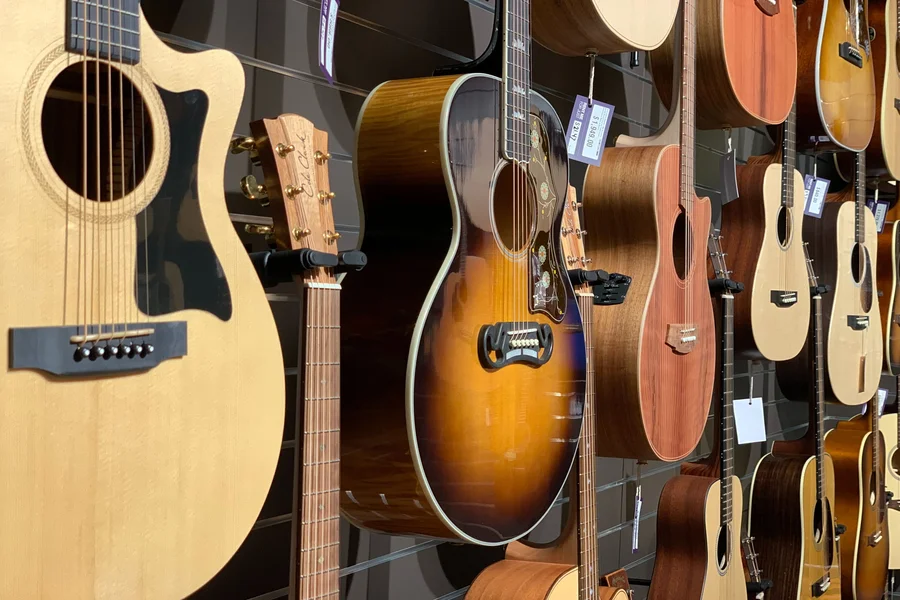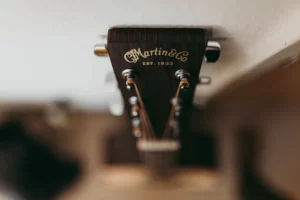Types of Acoustic Guitar
There are many different types of guitars on the market today, but the most popular type for beginners is an acoustic guitar. Acoustic guitars are one of the most popular instruments in the world. They come in all shapes and sizes, with different woods, pickups, and strings. The differences between each guitar can make it difficult to know what kind might be best for your needs. This blog post will explore different types of acoustic guitars and their unique tonal qualities. We will also discuss the features you should consider when purchasing an acoustic guitar. So, whether you’re a beginner guitarist or a seasoned pro, read on to learn more about the different types of acoustic guitars!
Acoustic guitars come in many shapes and sizes, but what’s the difference between them all? Here are the most common types:
- Dreadnought
- Jumbo
- Concert
- Grand Auditorium
- Parlor
- Nylon string guitar
- Steel-string guitar
Each type has its unique sound and feel. We’ll discuss each type in depth to make you understand which one is right for you?

Dreadnought Guitar
A dreadnought guitar is a type of acoustic guitar that is larger than a standard acoustic guitar. Dreadnought guitars are named after the HMS Dreadnought; a British battleship launched in 1906. The dreadnought guitar was designed to have a larger sound than a standard acoustic guitar, and many other guitar manufacturers have copied the design.
They are typically used for acoustic blues, country, folk, and bluegrass music. Dreadnought guitars can also use it for electric guitar effects, such as overdrive and distortion. Many electric guitar players also use dreadnought guitars to get a more acoustic sound. In addition to their increased size, they have a rounder and warmer tone than an electric guitar.
Dreadnought guitars are usually made from wood, such as cedar or rosewood. Other materials occasionally used include mahogany and maple. Dreadnought guitars are popular with guitarists of all experience levels, from beginner to professional. Dreadnought can use them for a wide range of music styles, and their larger size makes them ideal for live performances.
All kinds of styles are available, from basic dreadnought models by different brands, e.g., Yamaha, Takamine, Fender, to high-end models with more features and decorations. Dreadnought guitars are a great choice for any guitarist who wants a bigger sound.
Pros
- They have a large, deep soundboard that produces a rich and powerful tone
- Their large size also makes them ideal for strumming and picking chords
- They have a comfortable neck and fret-board that make them easy to play
Cons
- They can be heavy, which makes it difficult to play for long periods
- They’re not as well-suited for finger-style playing as other guitar shapes
- They can be harder to find a good fit if you have smaller hands
Jumbo Guitar
A jumbo guitar is a specific type of acoustic guitar. Even though acoustics, its sound quality can be very similar to an archtop or electric guitar. Its size and shape contribute greatly to its unique tone, making them perfect for solo performances or accompaniment in a large ensemble. They have a great sound quality but are not too heavy to carry around easily makes them very versatile.
Jumbo guitars are characterized by their large bodies, which can vary in depth and width depending on the player’s needs. The term “jumbo” also may refer to an acoustic guitar with a larger-than-normal body that produces an extra bass response.
They were originally designed for classical and Spanish guitarists in the early 1900s, who needed a bigger instrument to fill larger venues. Jumbo guitars quickly became popular with blues and country artists in the 1930s and 40s.
Jumbo guitars have a six-stringed body which is usually larger than the average size of an acoustic guitar. The shell may be made out of mahogany or rosewood, depending on the style and country where they were built in. They often have a cutaway in the body to make it easier for players to reach higher notes on the fretboard.
The size of a jumbo guitar makes it perfect for finger-picking, which is a style of playing that uses your fingers to pluck the string instead of using a pick. It can be a great way to get a mellower sound out of the guitar.
Pros
- Produce greater volume of tone
- Versatile can be used in many different genres of music
- Produce lower frequencies more efficiently
- Perfect for finger-picking and strumming
Cons
- Require greater strength to play for long periods
- Harder to find the right amplifier for them
- Less portable than smaller types of guitars
- Tend to be less comfortable to play for individuals with smaller hands
Concert Guitar
Concert guitars are typically designed for classical and Spanish-style music. They are slightly smaller than traditional acoustic guitars, making them more comfortable to play when sitting down. The strings on a concert guitar are usually thinner and lighter than those on most other types of guitars.
These smaller, lightweight instruments provide comfort for both the player and listener with their gentle sound quality that is not overpowering or distracting in any way. The design makes it easy to hold down chords when playing; however, some players can feel too small.
A concert guitar’s sound is comparably softer and lighter than that produced by other guitars, but the tone remains full and rich in quality with good resonance. For this reason, they are sometimes called “semi-acoustic” instruments because of their unique ability to produce a clear sound without being too loud.
Pros
- They produce a beautiful, full sound that is perfect for concerts or other large venues
- Thinner, lighter strings make them easier to hold down chords
- Produce a clear sound without being too loud
Cons
- The large soundhole, thicker neck, and wider fingerboard may cause some users to struggle with their playing
- They can be tricky to tune (especially if you’re not used to tuning in fifths)
- Tend to be more expensive than regular-sized guitars
Grand Auditorium Guitar
A grand auditorium style is the perfect all-purpose travel and recording guitar, especially if you’re an acoustic guitarist who wants something more than just dreadnoughts and jumbos.
The body size of the Grand Auditorium is between that of a Dreadnought (bigger) and a Jumbo (smaller). Fingerstyle players design grand auditorium guitars, but they also work well for Flatpicking guitar styles. If you’re looking to record your acoustic instrumentals with something more than just the bare bones of an acoustic guitar sound, this might be what you need.
This model is also great for singer-songwriters who need a well-rounded acoustic guitar with plenty of volumes to fill a room. The shape and size make the grand auditorium perfect for both studio and stage use.
Grand Auditorium guitars usually have a woody and mellow tone, often described as “warm.” The sound is not as loud as a Dreadnought, but it is not quiet. If you’re looking for an acoustic guitar that can handle delicate finger-style playing and has a nice, mellow sound, the Grand Auditorium might be perfect for you.
Pros
- They are well-balanced and have a strong, clear midrange
- They can be used for a variety of genres, from country to classical
- The shape and size make the grand auditorium perfect for both studio and stage use
Cons
- Some designs can be expensive, depending on the materials used
- The lack of a cutaway means the player cannot reach the highest frets easily
- The body may be too large for smaller players or children
Parlor Guitar
The term “Parlor Guitar” typically refers to a smaller-bodied acoustic guitar designed for personal rather than public or professional use. Parlor guitars are often favored by singer-songwriters and other musicians who need a guitar that is easy to transport and that has a more intimate sound.
Parlor guitars vary widely in their construction. Typically, however, they have a full or ¾-size body that is more slender than a traditional acoustic guitar. They also typically have a shorter scale length, making them easier to play.
The thickness of the body on a parlor guitar can also vary greatly, from very thin (under 0.25 inches) to very thick (over .75 inches). Many parlor guitars are built with a spruce or cedar top, which helps to produce a bright and clear sound. Mahogany is a common choice for the back and sides of a parlor guitar, as it helps to create a warm and mellow tone. Parlor guitars are typically used for personal practice, house concerts, and small acoustic gigs.
Pros
- Short scale length makes the strings easier to press down
- They are typically less expensive than other acoustic guitars
- Many modern artists use parlor guitars in their music – from Bruce Springsteen’s “Nebraska” to Taylor Swift’s “Red”
Cons
- They are not as well-suited for beginners as they can be more difficult to play
- They are not as loud as other acoustic guitars, making them less ideal for use in a band setting
Nylon String Guitar
The term “Nylon String guitar” typically refers to classical or Latin acoustic guitars designed for nylon strings instead of metal. Nylon string guitars are typically used in types of music that range from folk to classical. Nylon string acoustic guitars can come with some different body types. The most common type is the classical guitar, which has a large, rounded body shape. Other types of nylon string guitars include the flamenco guitar (which typically has a small, thin body) and the Latin American guitar (which can have various body shapes).
Due to the types of music that a nylon string acoustic guitar typically uses, this instrument has a bright tone. It means it can sometimes sound too bright and sharp with certain players who prefer a mellower acoustic guitar sound.
Pros
- Softer on your fingers, especially if you play barehanded
- Easier to press down compared to steel strings, which is great for beginners
- Produce a mellower sound that can be perfect for classical and fingerstyle playing
Cons
- More prone to breaking, especially if not properly cared for
- Difficult to keep in tune with, which is a hassle if perform.
- Have a thinner gauge, so more challenging to play if playing with thicker strings.
Steel String Guitar
When most people think of guitars, the first type that comes to mind is the steel-string acoustic. As the name suggests, this guitar has steel strings, which are traditional guitar strings. They are also called flat-top guitars because the tops of their soundboards are usually flatter than other acoustic guitar types. Steel-string guitars usually have a longer scale length than classical or flamenco style guitars and can therefore be harder to play for beginners. The strings of a steel-string guitar are usually tuned in intervals of fourths rather than the thirds used on other acoustic guitars.
There are many different types of steel-string guitars available on the market today, so beginners need to know the differences between them. A good starting point when considering choosing a guitar for beginners would be types of guitars. There are many different acoustic guitar bodies, each unique sound and look.
Pros
- A bright, punchy sound that is perfect for country and rock music
- An excellent way to learn lead and rhythm guitar techniques
- Easy to play and affordable
Cons
- Quite loud
- Not as well-suited for classical or jazz music
- Sound very thin when using a pick
Conclusion
So, there you have it! A variety of shapes and types of acoustic guitars for all players to explore. Whether you are just starting or are a seasoned pro, there is an acoustic guitar out there that will fit your needs. Acoustic guitars come in all shapes and sizes, and what may suit one player perfectly might not be the right fit for someone else. The most important thing to keep in mind is that the shape of the acoustic guitar should be based on your playing style and not the other way around.
Read more:














